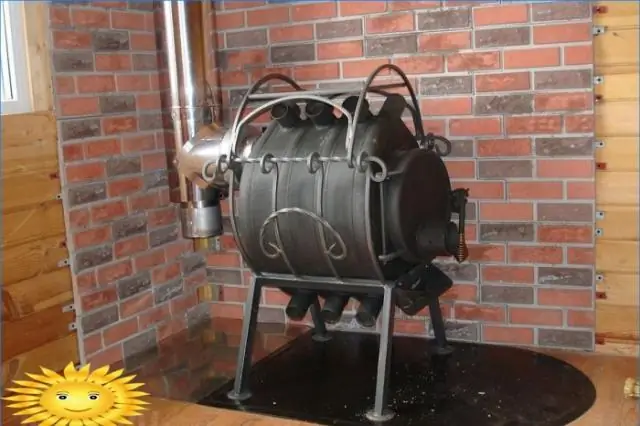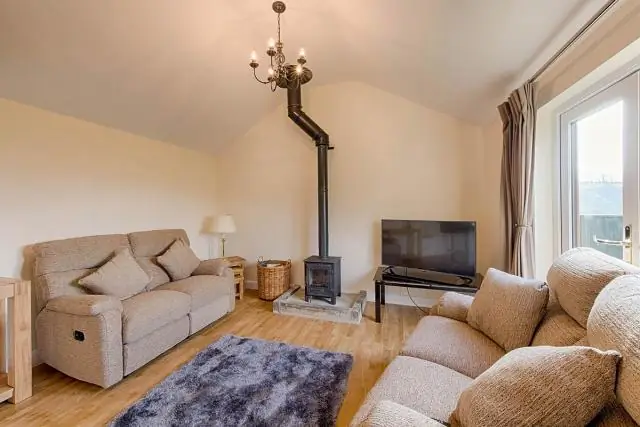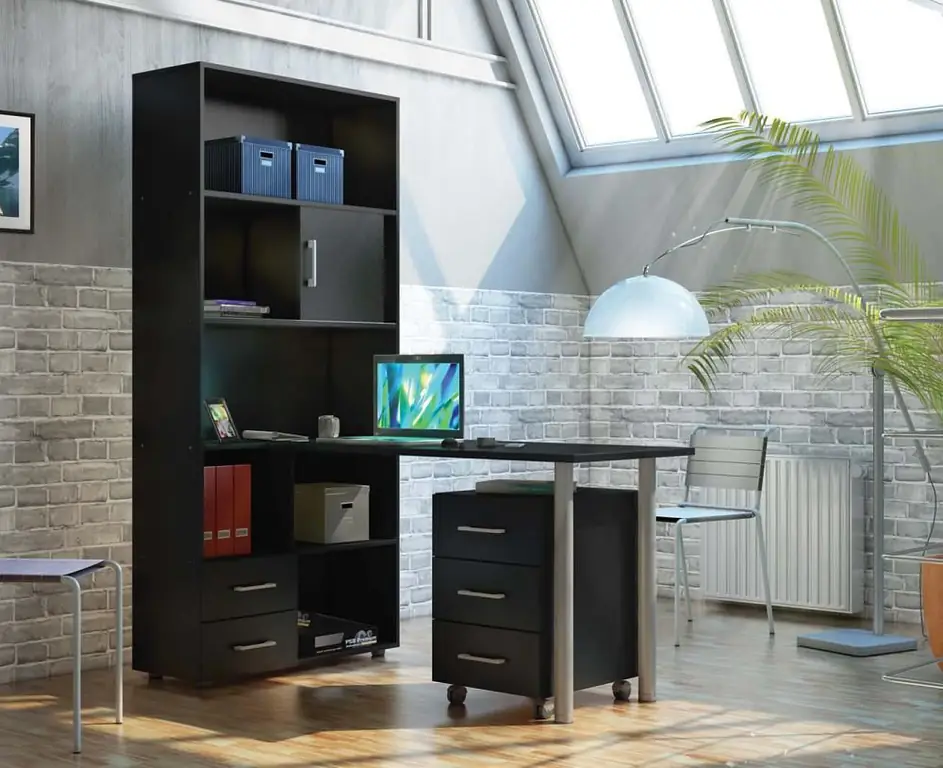
Table of contents:
- Long-burning pyrolysis oven "bubafonya": how to do it yourself
- What is the long burning process
- Long burning stoves "bubafonya"
- Design and working principle
- DIY "bubafonya" oven
- Materials and tools
- Preparatory work for the installation of a gas cylinder stove
- Features of operation
- Furnace cleaning and repair
- Author Bailey Albertson [email protected].
- Public 2024-01-17 22:26.
- Last modified 2025-06-01 07:32.
Long-burning pyrolysis oven "bubafonya": how to do it yourself

It is no secret that many successful technical solutions are born by home craftsmen in the implementation of their ideas. Heating devices are one example. As a result of DIY alterations to fit your needs, they are becoming more and more efficient in terms of price-quality ratio, even when heating the home. This is especially true for the Bubafonya pyrolysis ovens, which burn furnace gas from low-grade fuel.
Content
- 1 What is the long burning process
-
2 Long burning stoves "bubafonya"
- 2.1 Scope
- 2.2 Advantages and disadvantages of the heating unit
-
3 Design and principle of operation
3.1 Principle of operation
-
4 Do-it-yourself bubafony oven
-
4.1 Determination of basic parameters
- 4.1.1 Optimal cabinet wall thickness
- 4.1.2 Pressure piston diameter
- 4.1.3 Press plate thickness
- 4.1.4 Size of the flue outlet
- 4.1.5 Section of the air supply pipe
-
-
5 Materials and tools
5.1 Photo Gallery: Furnace Making Tools
-
6 Preparatory work for the installation of a gas cylinder stove
- 6.1 Installation
- 6.2 Bubafonya with a water jacket
- 6.3 Design options
- 7 Features of operation
- 8 Cleaning and repairing the oven
What is the long burning process
To understand how to properly make a metal stove, you need to consider what the combustion process is. This should be done using the example of the most common type of fuel - wood.
Ignition is carried out with easily combustible objects from wood chips and birch bark to flammable liquids. Until the surface temperature of the wood reaches a temperature of 100 degrees, a whitish smoke rises from them, which is a vapor of leaving moisture. It is always contained in them, regardless of storage conditions.
When the temperature reaches 250 degrees, the surface of the wood begins to char, decomposing into chemical components of simpler composition. Under the influence of atmospheric oxygen, the reaction proceeds more and more intensively. When the temperature reaches 300 degrees, the wood substance begins to decompose into gaseous components that actively enter into the oxidation reaction. They are flammable and give a high flame temperature. Unfortunately, the fuel loading burns out quickly and the stove “requires additional feeding”.
Long burning stoves "bubafonya"
There are many designs of long burning stoves. The difference between their device is the metered air supply to the furnace. A decrease in its supply leads to a slowdown in oxidation and a more complete use of fuel. The intake is adjusted through the firebox and ash pan with special dampers, that is, from below.

Sawdust furnace design option
In the bubafon oven, air is supplied from above through a hollow rod. In this way, the effect of gradual fuel combustion is achieved without heating the underlying layers. When such a thermal unit warms up to a temperature of 300 degrees or more, the process of wood pyrolysis begins. Combustible furnace gases enter the upper part of the furnace and burn there with the release of a large amount of heat. That is, wood fiber burns at the bottom with the release of combustible gases that ignite on top of the piston.

The principle of operation of the long-burning furnace Bubafonya with a water-heating jacket and an ash pan
Application area
Depending on the capacity of the furnace, the combustion of one fuel load can last from 12 to 24 hours. It is convenient when used in heating systems of a country house, greenhouses, garages and industrial premises.
Advantages and disadvantages of the heating unit
The advantages of such a furnace include the following factors:
-
The simplicity of the design, which allows you to make it yourself.

Pyrolysis oven The simplest bubafony oven
- A pyrolysis furnace of this design provides ample opportunities in choosing the type of fuel. It can successfully burn woodworking waste in the form of sawdust, chips, small trimmings. Such a heating unit can also operate on peat briquettes, low-grade coal and fuel pellets.
- Long working time, up to a day. But it depends on the air flow rate and the volume of the combustion chamber.
However, there are a number of significant disadvantages of this design:
- Bubafonya has a low efficiency. This can be attributed to the uneven heating of the furnace body, which results in a decrease in the degree of heat transfer from the unit. For pyrolysis furnaces of improved designs, the efficiency can reach 90%.
- Bubafonya of classical design is inconvenient for cleaning from fuel combustion residues. They have to be removed from the top. But this drawback is easily eliminated by the device of the door at the bottom of the fuel tank. The door should close tight enough to minimize air flow through it.
- Unattractive appearance. The stove looks rough and does not decorate the interior when installed in a residential building.
Design and working principle
The device of the stove is quite simple. It consists of four main nodes:
- Housing. For its manufacture, a household gas cylinder is often used. The upper part is cut off on it, which is subsequently used to make the furnace head.
-
Cap. A hole for the stem is cut in the cut off part along the axis. For ease of use, handles from any suitable material are welded to this part.

Cap Bubafonya stove head when made from a cylinder
-
Stock. It consists of a pipe through which air enters the heating unit. In its lower part a piston is welded to seal the fuel. On the lower surface of the piston, ribs must be installed to provide a gap between it and the surface of the fuel layer. A damper is installed in the upper part of the pipe, which allows regulating the air supply to the combustion chamber.

Homemade ovens Bubafonya stove rod
- Chimney. It is discharged through the top of the combustion chamber directly under the cover.
Operating principle
To consider how the bubafon pyrolysis furnace works, you need to describe in detail the full cycle of fuel combustion:
- Loading the furnace. It is produced with small firewood mixed with shavings and sawdust. The more densely it is laid, the longer the bookmark will burn out. The fuel level should be 15-20 centimeters below the chimney. Loading is carried out with the cover removed and the stem removed.
-
Furnace ignition. A rag soaked in flammable liquid should be placed on top of the fuel. You can use diesel fuel, kerosene or a special liquid for ignition.

Homemade pyrolysis ovens loading the furnace and igniting the bubafonya furnace
- Installation of the rod. It is applied directly to the fuel layer, after which a cover is put on it.
- When the damper is fully open at the top of the stem, an ignited lump of rags is dropped into the stem tube. If you just throw a match there, it will go out along the way.
-
Fuel combustion occurs from flammable liquids, a thrust is created in the stem tube and the furnace begins to heat up. Full access to the pyrolysis mode occurs within 15-25 minutes, after which the combustion of furnace gases begins in the upper chamber. At this time, you need to close the damper on the stem pipe, reducing the air supply to the furnace.

Two-chamber oven Long burning pyrolysis unit
- As the wood burns out, the stem falls under its own weight. The ribs welded onto the piston do not allow the rod to completely cover the fuel layer, ensuring uniform combustion.
- The furnace operates until the stem is completely lowered, which indicates the end of the cycle. In this case, the heating unit dies out. Next, you need to clean the ash from the furnace and repeat the load.
Remember! Do not load fuel vertically. If a piece of wood hits the stock, it can make it difficult to advance. The combustion mode will be violated.
DIY "bubafonya" oven
Determination of the main parameters
The main proportion used in calculating the dimensions of the furnace is the ratio of the inner diameter to the height of the body. Optimally, it should be 3-5: 1. The recommended inner size is 30 to 80 centimeters. A smaller body is ineffective because air will move too quickly through the combustion chamber. Contact with fuel will be defective, reducing the efficiency of the device. With a size of more than 80 centimeters, the outer layers of fuel will burn more slowly than the inner ones, the rod will fall into the bookmark and combustion in the firebox will become impossible.
Optimal cabinet wall thickness
Optimal heat transfer occurs with a wall thickness of 4-5 millimeters. At a lower thickness, the body can quickly burn out.
Pressure piston diameter
The size of the gap between the walls of the body and this part should be optimally about 5% of the internal diameter of the furnace. That is, the piston diameter is determined from the ratio:
D = Dsht * 0.9
D - inner diameter of the swamp
D pcs - rod diameter.
For example, with an inner diameter of the body of 40 centimeters, the stock size will be: 400 * 0.9 = 360 millimeters.
Pressure plate thickness
This parameter also depends on the size of the combustion chamber, but in inverse proportion. Functionally, this part is needed to create pressure on the fuel. In case of insufficient exposure, the principle of operation of the furnace may be violated - the opposite action. As a result, the furnace ignites with the formation of reverse draft. In this case, the combustion products go into the suction pipe. With excessive pressure, the rod will simply fall into the fuel layer and the bubafoni will stop burning.
We present sample data of the dependence of the thickness of the pancake on the diameter of the furnace in centimeters:
- 30 - 6-10.
- 40 - 6-8.
- 60 - 4-6.
- 80 - 2.5-5.
There are no categorical requirements or strict restrictions on this parameter, but it is better to adhere to the given proportions.
Chimney outlet size
This indicator is the most important, since the mode of gas flows in the thermal unit depends on it. The heat engineering calculation is very complicated and takes into account a large number of parameters. In practice, an empirical relationship has been established:
S = 1,75E where
S - cross-sectional area of the chimney:
E - furnace power output, kW / hour.
The E index can be determined from the ratio:
E = e * M where
e is a tabular value that represents the specific heat output of a particular fuel:
M - mass of a single batch of fuel is determined as the product of the mass loading on the specific volume of the fuel space, kg / dm 3.
Here are some reference data on the specific heat capacity of solid fuel, kW / h:
- Standard size aspen firewood - 2.84.
- Sawdust or softwood shavings - 3.2.
- Alder pellets - 3.5.
- Hard coal of the DPK grade - 4.85.
- Coal grade SSOM - 5.59.
- Peat briquettes - 2.36.
The most commonly used chimney size is 150 mm if the fuel part of the furnace is at least 2/3 of the total body height.
Air supply pipe section
This dimension is 0.5-0.57 times the diameter of the flue pipe. In our case, the size 76-83 mm can be recommended.
Materials and tools
To make a bubafony oven, you will need:
-
An old gas cylinder or a piece of steel pipe of the required diameter.

Metallic oven from a cylinder Using an old gas cylinder for a furnace
- Steel sheet 6-8 mm thick (if the oven is from a cylinder).
- The same, 1.5-2 mm thick for the ash pan.
- Non-equal angle 25x40 mm for making a pocket for a wedge lock for a cover.
-
Profile pipe or channel for additional heat exchangers.

Greenhouse oven Application of additional heat exchangers
- Steel strip with dimensions 40x2-4 mm for the bolt wedge and handles on the cover.
- Galvanized steel sheet 1200x1200x0.7 mm.
- Asbestos sheet 10 mm thick.
The listed materials can be replaced by other suitable ones from availability.
List of tools:
- Angle grinder (grinder) - for cutting metal parts.
- Household welding machine.
- Electrodes matching the material of the parts.
- The device for flame cutting of metal.
- Electric drill.
- Steel brush for electric drill.
- Semicircular file.
- Personal protective equipment - shields, gloves, etc.
Photo Gallery: Furnace Making Tools
-

Cutting tool - Bulgarian
-

Welding - Household inverter
-

Power tool - Drill
-

Metal cutting - Gas cutter
In addition to those listed, you may need other general-purpose tools.
Preparatory work for the installation of a gas cylinder stove
The use of welding during installation will require a room with good exhaust ventilation. If it is not available, it is allowed to work in the air.
Further actions may look like this:
-
Development of a draft design of a heating unit with the production of drawings of parts.

Boiler drawings Solid fuel boiler with bubafonya stove
- Purchase of materials.
- Manufacturing of parts.
Mounting
The assembly of the unit is carried out in the following order:
-
Carefully cut off the top of the can.

Lid compartment Cutting a cylinder with a grinder
-
Make a hole in the resulting cap along its axis. Its size should be 2-2.5 mm larger than the corresponding outer dimension of the inlet pipe (stem).

Cover blank Cap from cylinder head
- Weld the handles to the cap.
- Weld the legs of the metal profile 25-30 cm high to the bottom of the cylinder, which is the furnace body.
-
Make a side hole for the chimney, weld on the outlet.

Pipe bend Chimney at right angles
- Weld the additional fins of the heat exchangers along the generatrix of the body.
-
Make a stock:
- Weld the piston pancake to the end of the intake pipe. Monitor alignment.
- Install a damper on its upper end to adjust the air supply.
-
Weld the 40 mm high supporting ribs to the pancake in the amount of 4-6 pieces.

Pancake for stock Option execution of the pressure side of the stem
- At the place of installation of the furnace, place an asbestos sheet on the floor, on top of which to lay galvanized and fix the resulting protective layer to the floor. Install the oven.
-
Install the chimney. For this:
- Install the elbow adapter onto the outlet.
- Attach a straight pipe to it in the direction of the wall.
- Install another reverse slope elbow adapter.
- After marking, make a hole of the required diameter in the wall.
- Install a straight horizontal chimney section through the wall. Attention! Its length should not be more than 1 meter.
- Install a condensate collector at the end of the horizontal section.
-
From it, vertically along the wall, mount a chimney of sandwich pipes.

Wall chimney External chimney with condensate collector
- Install the chimney head.
Important! The height of the chimney must be less than 5 meters from the level of the outlet from the oven.
Bubafonya with a water jacket
To organize water heating of a country house, such a heating unit can be used as a boiler. To do this, a container in the form of a water jacket is welded onto it. You can use a metal barrel by cutting a hole in the bottom for the cylinder. The height of the casing must reach the outlet of the chimney. From above, the shirt is welded with a ring piece between the body and the barrel.
The outlet for the water supply is installed in the upper part of the shirt, the return pipe is in the lower. An indispensable accessory for the heating system is an expansion tank with a membrane. Depending on the design of the heating circuit, it can be gravity with natural circulation or forced using a circulation pump.

Bubafon stove with a water jacket in the heating system
By the same principle, you can arrange a jacket on the furnace body.
Design options
Another basis for a bubafony stove can be:
- Metal barrels of various sizes, for example, 100 and 200 liters. The smaller one serves as a furnace body, the larger one plays the role of a hot water boiler.
- Large diameter steel pipes. For the oven, you can purchase such products on the secondary market. The pipe metal is weldable and highly durable. Additional costs are associated only with the need to weld the sheet metal bottom.
Features of operation
The heating unit needs increased attention only in the first period after the start of operation. This is necessary in order to understand all the features of a particular oven. For this:
- After starting, you need to burn several plugs of fuel of different moisture content to determine the time of complete combustion. But you can also get information about the required amount for various combustion modes.
- It is better to make the chimney collapsible to facilitate cleaning.
- The room with the stove should have a fire extinguisher and a box of sand.
- It is necessary to regularly inspect the stove for burnouts and leaks of combustion products.
Furnace cleaning and repair
The measures for the care of the same heating unit are as follows:
- During the period of intensive operation, it is necessary to drain the condensate from the collector weekly.
- Before the start of the heating period, the chimney should be cleaned of soot.
- Do not use waste plywood, chipboard and other materials with synthetic binders as fuel.
There is no doubt that many home craftsmen are still working to improve the design of metal stoves. The day is not far off when we will learn new solutions in such a difficult matter as home heating.
Recommended:
Recipe For A Classic Charlotte With Apples In The Oven, Bread Maker, Etc. + Photo And Video

Step-by-step recipes for several types of charlotte. Essential ingredients, tips and cooking secrets. Baking in the oven, bread maker, slow cooker
Making A Buleryan (breneran) Stove With Your Own Hands: Advantages And Disadvantages Of The Design, A Device With Drawings, Instructions With A Video, Etc

Design and principle of operation of the "Buleryan" furnace (breran). DIY recommendations with instructions and drawings. Maintenance and operation
How To Make A Long Burning Stove With Your Own Hands: Manufacturing Instructions With A Diagram And Drawings + Video

How to make a long burning stove with your own hands. Consumables, recommendations, diagrams, design features
Long-term Burning Stove (including Sawdust And Wood) With Your Own Hands: Diagram, Drawings, Etc. + Video

How does a long burning stove work. Production of a long-burning furnace from a gas cylinder and sheet metal. Features of operation and repair of furnaces
How To Make A Comfortable Computer Desk With Your Own Hands: Drawings, Diagram, Detailed Instructions + Video

Practical advice and recommendations for making a computer desk. Required materials and tools, step by step instructions
